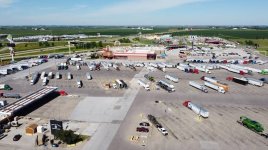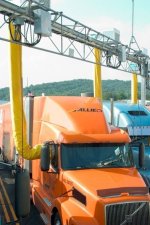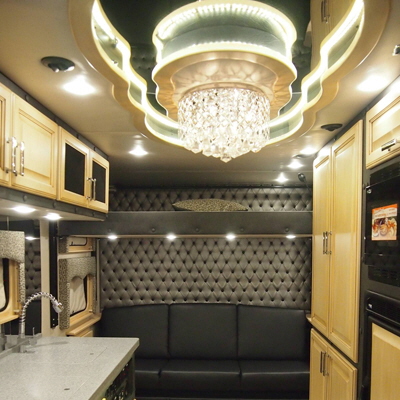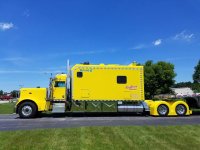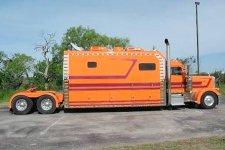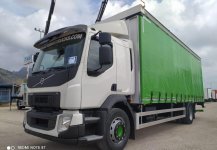Patrick_R
Grand Master
Great question Sean.
Here and the USA are pretty much the same as we have a country roughly the same size, with very little rail infrastructure for goods, so the heavy lifting is done by trucks. Especially when it comes to frozen or refrigerated goods.
Train carriages/wagons are mainly for dry goods, not cold.
So the market is pretty much the same. Trucks are needed to deliver anything and everything right around the country.
It’s the needs that differ from our country to theirs.
Europe is entirely different, as they have a great rail network for goods, plus very short distances.
However they have a very unique goods transport via ships to all the various other countries where loaded trailers are deposited on the ships, and the trucks leave, and a different truck collects them at the next port. Something we don’t do.
Where Australia differs, is that unlike North America, we have a vast expanse of nothing due to no water for 90% of the country, but people still live there, poor roads (if any) and certainly no rail.
The expanses of the US with no water is quite small, and you have major states and cities from north to south, east to west due to their vast expanse of rivers and waterways etc plus great roads that go between.
You don’t see any “outback truckers” in the USA like we have here.
So the trucks differ in what they need to do, plus the laws are extremely different.
The below pics show the Tesla Semi, and a typical Volvo for Australia.
The USA have very little rules when it comes to length regarding trailer to truck dimensions as the red markers indicate.
However they do have some overall length restrictions, which then impacts on trailer length thus payload.
Plus they (as we have discussed) don’t do much super heavy maximised multi trailer loads as we do.
We also have very strict axle load weights where the USA not so much.
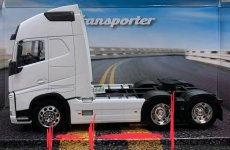

We maximise payloads and run maximum weights, where the USA don’t really do this.
Our trucks will keep the same trailer and maybe drive from Brisbane to Melbourne doing one high weight load, where in the USA, they may pick up and drop off trailers three or four times doing pick ups and drops along the same distance.
Their typical 18 wheelers (as we know them) are fairly light weight probably high 20’s to mid 30 tonnes.
Our typical 22 wheelers are from high 30’s to mid 50 tonnes.
Typical trucks in the USA 18 wheeler. Long nose huge sleeper bunk short trailer.
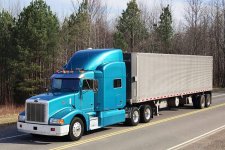
Typical Australian 22 wheeler.
Note how much trailer is in front of the tow coupling or past the second axle from the rear.
Short nose, smaller sleeper, longer trailer more axles = more weight.
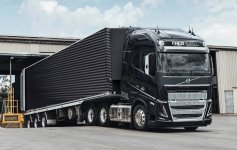
I guess, we want to carry more further in one trip, with our very strict rules regarding weight, length etc where the Americans don’t usually do this.
Regarding range.
Both the Tesla & Volvo heavy duty can do roughly 500km per charge.
Down side is massive batteries doing this massive job, takes an extremely long time to charge.
Usually in excess of 8 hours.
Good IF there are suitable chargers at the truck stops.
Our drivers have to do 12 hours on, 12 off, so this is great for charging if the infrastructure is there dotted around the country, which of course at present, it’s not.
Here and the USA are pretty much the same as we have a country roughly the same size, with very little rail infrastructure for goods, so the heavy lifting is done by trucks. Especially when it comes to frozen or refrigerated goods.
Train carriages/wagons are mainly for dry goods, not cold.
So the market is pretty much the same. Trucks are needed to deliver anything and everything right around the country.
It’s the needs that differ from our country to theirs.
Europe is entirely different, as they have a great rail network for goods, plus very short distances.
However they have a very unique goods transport via ships to all the various other countries where loaded trailers are deposited on the ships, and the trucks leave, and a different truck collects them at the next port. Something we don’t do.
Where Australia differs, is that unlike North America, we have a vast expanse of nothing due to no water for 90% of the country, but people still live there, poor roads (if any) and certainly no rail.
The expanses of the US with no water is quite small, and you have major states and cities from north to south, east to west due to their vast expanse of rivers and waterways etc plus great roads that go between.
You don’t see any “outback truckers” in the USA like we have here.
So the trucks differ in what they need to do, plus the laws are extremely different.
The below pics show the Tesla Semi, and a typical Volvo for Australia.
The USA have very little rules when it comes to length regarding trailer to truck dimensions as the red markers indicate.
However they do have some overall length restrictions, which then impacts on trailer length thus payload.
Plus they (as we have discussed) don’t do much super heavy maximised multi trailer loads as we do.
We also have very strict axle load weights where the USA not so much.


We maximise payloads and run maximum weights, where the USA don’t really do this.
Our trucks will keep the same trailer and maybe drive from Brisbane to Melbourne doing one high weight load, where in the USA, they may pick up and drop off trailers three or four times doing pick ups and drops along the same distance.
Their typical 18 wheelers (as we know them) are fairly light weight probably high 20’s to mid 30 tonnes.
Our typical 22 wheelers are from high 30’s to mid 50 tonnes.
Typical trucks in the USA 18 wheeler. Long nose huge sleeper bunk short trailer.

Typical Australian 22 wheeler.
Note how much trailer is in front of the tow coupling or past the second axle from the rear.
Short nose, smaller sleeper, longer trailer more axles = more weight.

I guess, we want to carry more further in one trip, with our very strict rules regarding weight, length etc where the Americans don’t usually do this.
Regarding range.
Both the Tesla & Volvo heavy duty can do roughly 500km per charge.
Down side is massive batteries doing this massive job, takes an extremely long time to charge.
Usually in excess of 8 hours.
Good IF there are suitable chargers at the truck stops.
Our drivers have to do 12 hours on, 12 off, so this is great for charging if the infrastructure is there dotted around the country, which of course at present, it’s not.

